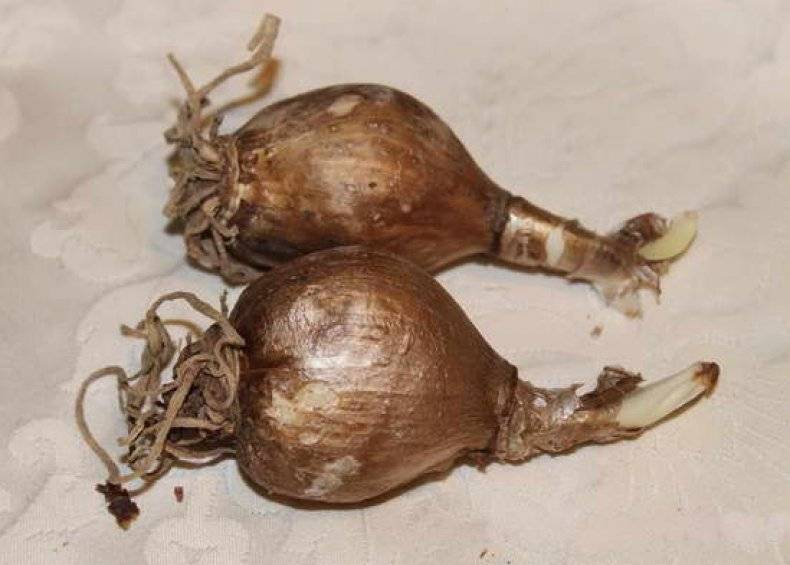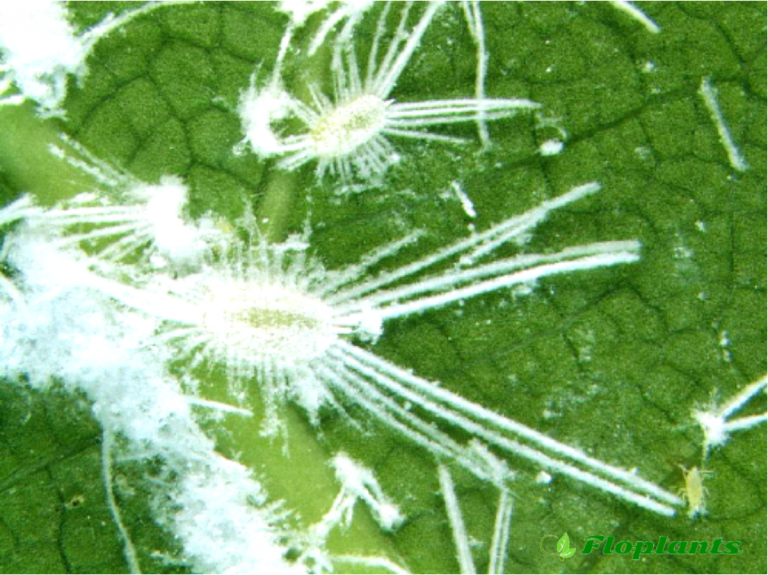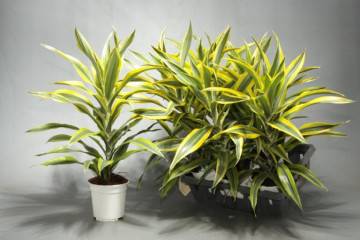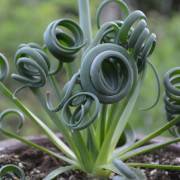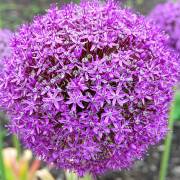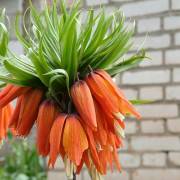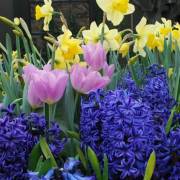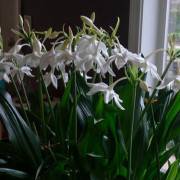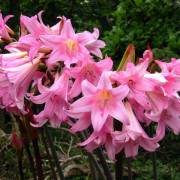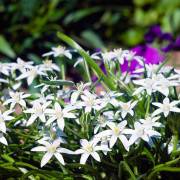Nerine: planting and caring for a plant for successful cultivation
Content:
Nerine, or nerina, is a tropical bulbous plant, a close relative of amaryllis. In nature, it grows exclusively in South Africa, from where it spread throughout the world as an ornamental flower. As a garden culture, nerine is almost never grown due to the severity of the continental climate. But at home, the flower feels good, and it can often be found in the collections of amateur flower growers.
Description of the flower
The handsome flower has flat narrow leaves of bright green color, long stems can reach half a meter. Flowers are funnel-shaped and are collected in inflorescences. The plant's bulbs are small in size, rarely exceeding 5-6 cm. The open buds have a diameter of 10 to 20 cm. The petals are narrow, slightly curled towards the bottom, have wavy edges. The color of the buds depends on the type of plant and can be white, pink, red or orange.
Nerina Bowden
Nerine Bowdenii is a common amaryllis species. Its popularity is due to the fact that the flower, unlike its species counterparts, is quite hardy and unpretentious. The bulb has a slightly elongated shape. The leaves are narrow, long, they have a bright green color and well-visible veins. Inflorescences have 7-10 flowers, similar to umbrellas. The color of the buds can vary from delicate lilac to almost lilac.
Nerina Bowden: growing and care
Care for this spectacular bulb depends on the season.
Winter period
In winter, flower buds form in the flower, so the plant needs to be provided with rest and a temperature regime that does not exceed 10 ° C. It is best to place the bulbs in a dry basement or on an enclosed balcony.
Spring period
In the spring, the pot with the bulb is taken out to a lighted place and provided with the necessary temperature regime within 22-24 ° C. During this period, life processes start in the bulb. You can tell by the way the bulb changes color. After some time, the first foliage will appear. And at this time, you need to start moderate watering.
Summer period
With the arrival of summer, the bulbous plant enters a dormant phase. A well-developed deciduous mass begins to dry out gradually, and dried leaves must be removed in a timely manner, cutting them off not near the bulb itself, but retreating 2-3 cm.
The temperature regime is still maintained in the range of 23-25 ° С. Watering should be gradually reduced, replacing it with infrequent spraying from a spray bottle.
Autumn period
End of August and beginning of September is the period of active vegetation of nerine. At this time, the plant needs to ensure regular watering and timely fertilization. In addition, before flowering, the topsoil should be removed and replaced with fresh. When the nerine fades, you need to stop watering and prepare the plant for wintering, that is, carefully cut off the leaves and peduncle and place it at rest in a dark, dry place. The plant's annual life cycle is over.
Nerine: landing and care
To grow nerine at home, you need to take a responsible approach to the choice of planting material, containers for planting and soil. Most likely, the flower shop will offer a choice of bulbs of this plant, although seeds can also be found.
Before buying, you should carefully examine the bulbs and assess their condition. It is worth abandoning the purchase if the bulbs show signs of rotting or suspicious stains.
Some agricultural firms offer already grown flowers for purchase. In this case, at home, the plant needs to create quarantine conditions for acclimatization.
Soil mixture for planting
Correctly selected soil mixture is one of the conditions for the successful cultivation of nerine. The flower prefers a nutritious but breathable soil. Usually it is purchased with the purchase of planting material, but you can prepare it yourself. To do this, you need to take turf, leafy soil, peat mixture and sand in equal proportions.
Drainage
Before planting, nerina should take care of good drainage, since this bulbous plant does not tolerate waterlogging of the soil. The pot must have a sufficient number of drainage holes. Expanded clay or medium-sized pebbles should be laid at the bottom so that excess water does not linger.
Pot selection
The nerin flower prefers to grow in some cramped conditions. But this does not mean at all that several bulbs need to be planted in one pot. It will be correct to place one onion in pots with a diameter of 13-15 cm. When planting, make sure that the upper part of the planting material protrudes above the ground.
Reproduction
Reproduction of nerine can be done in two ways - by seeds and baby bulbs.
Seed propagation
As a rule, the seeds of this flower do not germinate well, so they need to be sown immediately after harvest. The planting material is deepened into a seedling container filled with vermiculite, at a distance of about 2-3 cm. After planting, the container is covered with glass or film to create a greenhouse effect.
Watering is carried out using a spray bottle. The optimum temperature for the emergence of sprouts is 22 ° C. If all conditions are met, the first shoots should appear in 15-20 days. Sowing of grown flowers should be carried out when they acquire several leaves.
Reproduction by baby bulbs
Separating babies from the mother's bulb is the easiest way to breed this capricious "southerner". The most suitable period for this is early spring. To do this, the plant is carefully removed from the pot and carefully cleaned of the earthy coma. The bulbs, which have already formed their own root system, are separated from the mother bulb and immediately planted in individual containers. They should be looked after as an adult plant.
Outdoor cultivation
Despite the fact that nerine is more of a houseplant, it can also be grown outdoors. Unfortunately, only southern regions with a mild warm climate are suitable for this.
Nerine is planted in open ground at the end of July. Before that, you should make sure that the area under the culture is not flooded with rainwater and is not swamped. The best place will be a place that is located at a certain elevation and is well warmed up by the sun's rays.
The bulbs are placed in the ground at a distance of 7-8 cm from each other and covered with a layer of mulch or sawdust.
Preparing for winter
Nerine does not differ in winter hardiness. However, the plant may well survive frosts down to -10 ° C. To do this, do not remove the layer of mulch that covers the bulbs.If more severe frosts are expected, then they should be removed from the ground along with a lump and brought into the house until spring.
Pests and diseases
The plant is often attacked by pests, and, in addition, it can suffer from various kinds of diseases.
Mealybug
The mealybug, which loves to feed on nerine juice, is not easy to spot. The first sign that the plant has attacked this harmful insect is the appearance of black spots on the leaves. The fight against insects should be started immediately by collecting it by hand or by rinsing it under a warm shower. After that, nerina should be treated with an insecticide at least twice with an interval of 10 days.
Root mite
Root mite is an insect that infects a plant bulb. Some gardeners claim that a soapy solution or a weak solution of manganese brings positive results, but it is better not to risk the health of the flower and resort to insecticide treatment.
Powdery mildew
If a white bloom appears on the plant, then it is most likely powdery mildew - a dangerous fungal disease. Unfortunately, folk remedies cannot cope with this disease. To cure a flower from powdery mildew, all parts of the plant should be treated with an antifungal agent purchased from a specialized flower shop.
Viral mosaic
The flower can be affected by viral mosaicism, the first symptom of which will be the appearance of white or yellow spots on the leaves of the plant. If more than 70% of the bush is affected, then the flower will most likely not be saved. If the localization of the disease is not too extensive, then the plant can be tried to cure with the help of special antiviral drugs.
As you can see from the article, this is a beautiful plant, but peculiar in cultivation. It can be planted both at home in a pot and on the street, but only in the south. In leaving, he is not at all capricious, but you should still know some subtleties. And then nerine will bloom long and profusely.


